Accounting Theories: Agency, Stewardship, and Liability Analysis
VerifiedAdded on 2022/10/11
|16
|3300
|12
Report
AI Summary
This report provides a comprehensive overview of accounting theories, focusing on agency and stewardship theories, and their practical implications. The report begins with an introduction to three key accounting theories: Agency Theory, Stewardship Theory, and Stakeholder Theory, defining each and highlighting their core concepts. It then delves into a detailed analysis of five journal articles. Three articles are analyzed through the lens of Agency Theory, examining their purpose, the theory's relation to the research, key findings, and implications for future research. Two additional articles are then analyzed through the lens of Stewardship Theory, following the same structure. The report concludes with a practical discussion on liability as an obligation, referencing accounting standards set by AASB and IASB. The analysis of each journal article includes the purpose of the investigation, how the theory relates to the paper's objectives, the key findings, and potential future avenues for research. This structure ensures a clear understanding of each theory and its application within academic research. The report also addresses practical questions related to accounting liabilities, providing real-world context to the theoretical concepts discussed. This report serves as a valuable resource for understanding the interplay between accounting theory and its practical applications.
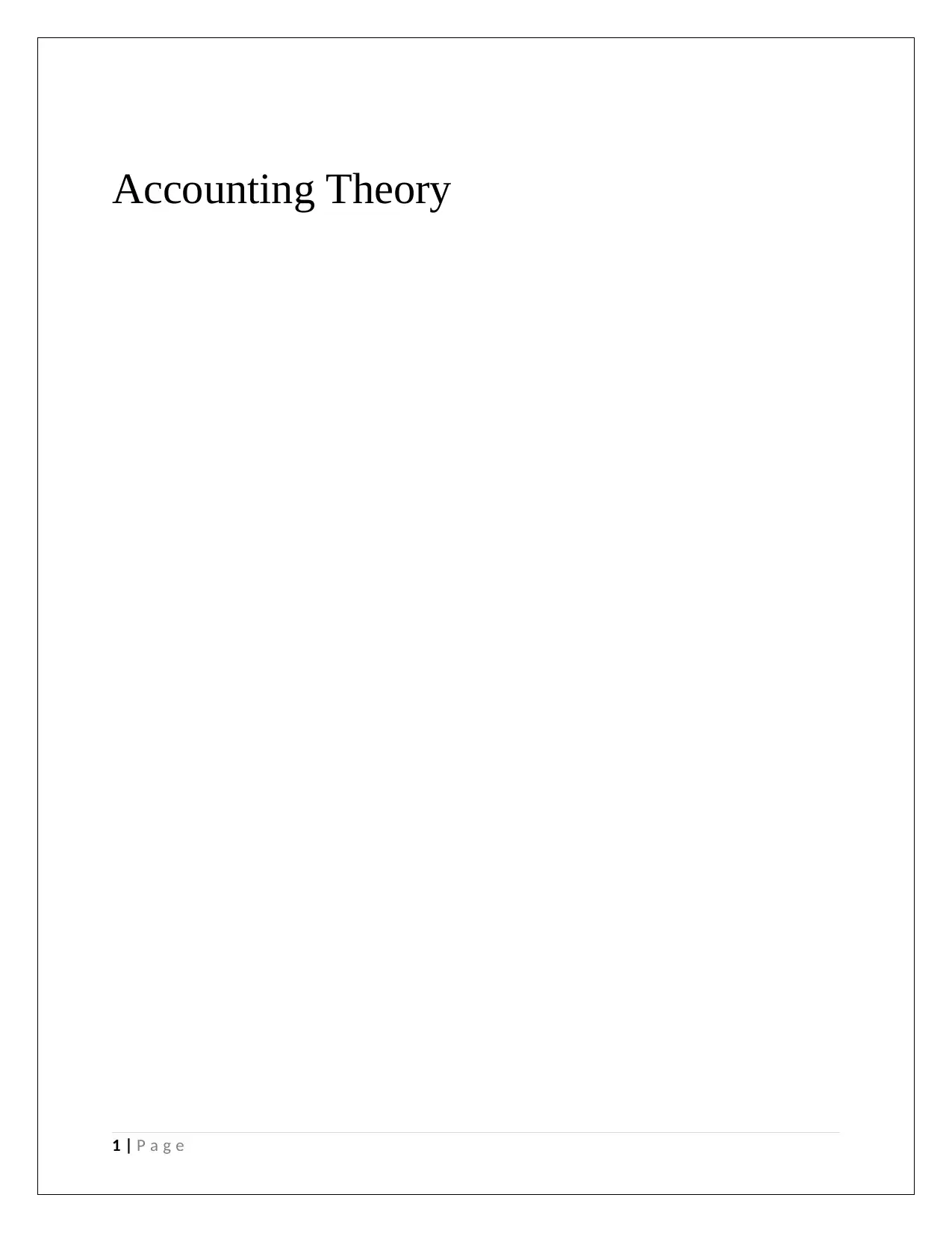
Accounting Theory
1 | P a g e
1 | P a g e
Paraphrase This Document
Need a fresh take? Get an instant paraphrase of this document with our AI Paraphraser
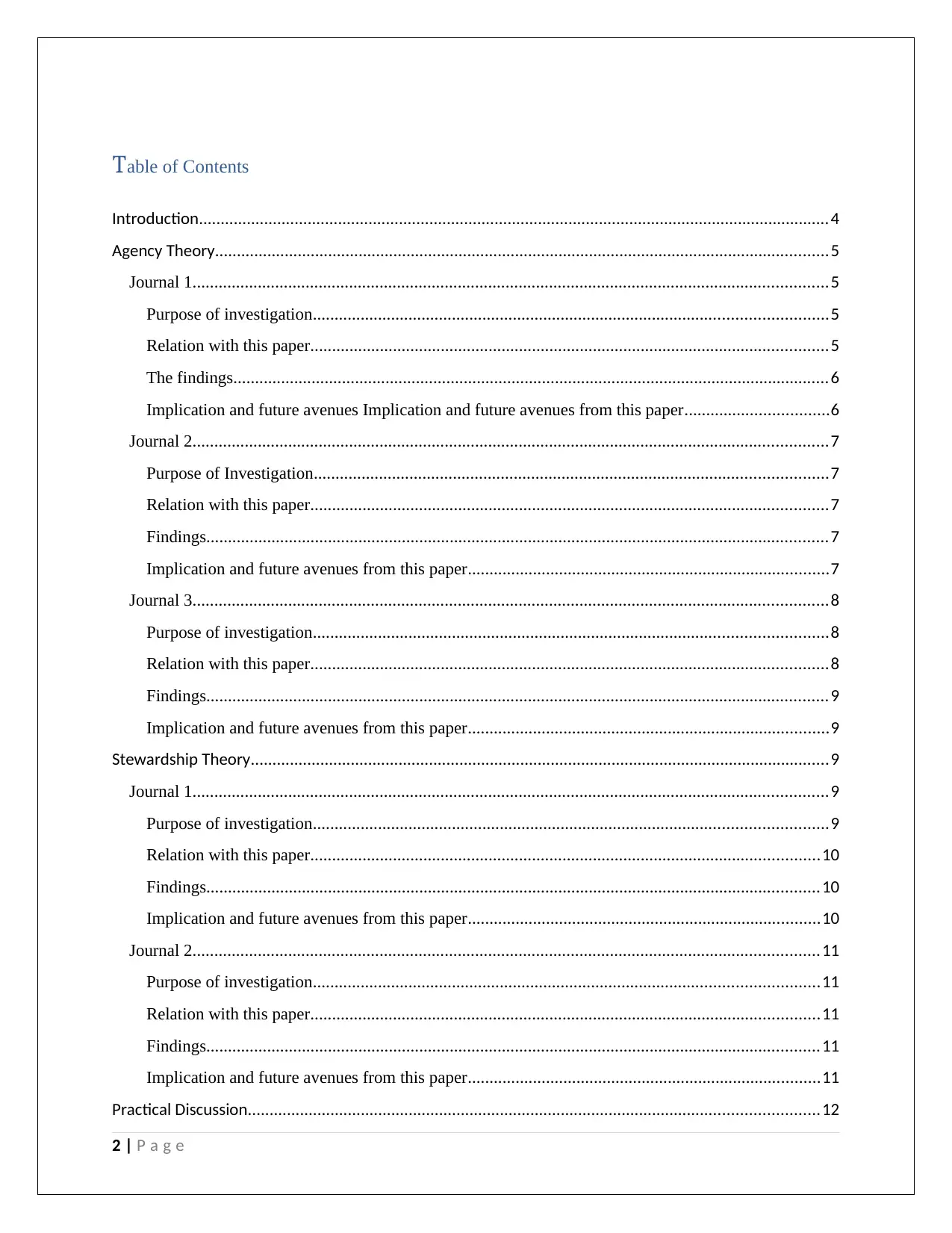
Table of Contents
Introduction.................................................................................................................................................4
Agency Theory.............................................................................................................................................5
Journal 1..................................................................................................................................................5
Purpose of investigation......................................................................................................................5
Relation with this paper.......................................................................................................................5
The findings.........................................................................................................................................6
Implication and future avenues Implication and future avenues from this paper.................................6
Journal 2..................................................................................................................................................7
Purpose of Investigation......................................................................................................................7
Relation with this paper.......................................................................................................................7
Findings...............................................................................................................................................7
Implication and future avenues from this paper...................................................................................7
Journal 3..................................................................................................................................................8
Purpose of investigation......................................................................................................................8
Relation with this paper.......................................................................................................................8
Findings...............................................................................................................................................9
Implication and future avenues from this paper...................................................................................9
Stewardship Theory.....................................................................................................................................9
Journal 1..................................................................................................................................................9
Purpose of investigation......................................................................................................................9
Relation with this paper.....................................................................................................................10
Findings.............................................................................................................................................10
Implication and future avenues from this paper.................................................................................10
Journal 2................................................................................................................................................11
Purpose of investigation....................................................................................................................11
Relation with this paper.....................................................................................................................11
Findings.............................................................................................................................................11
Implication and future avenues from this paper.................................................................................11
Practical Discussion...................................................................................................................................12
2 | P a g e
Introduction.................................................................................................................................................4
Agency Theory.............................................................................................................................................5
Journal 1..................................................................................................................................................5
Purpose of investigation......................................................................................................................5
Relation with this paper.......................................................................................................................5
The findings.........................................................................................................................................6
Implication and future avenues Implication and future avenues from this paper.................................6
Journal 2..................................................................................................................................................7
Purpose of Investigation......................................................................................................................7
Relation with this paper.......................................................................................................................7
Findings...............................................................................................................................................7
Implication and future avenues from this paper...................................................................................7
Journal 3..................................................................................................................................................8
Purpose of investigation......................................................................................................................8
Relation with this paper.......................................................................................................................8
Findings...............................................................................................................................................9
Implication and future avenues from this paper...................................................................................9
Stewardship Theory.....................................................................................................................................9
Journal 1..................................................................................................................................................9
Purpose of investigation......................................................................................................................9
Relation with this paper.....................................................................................................................10
Findings.............................................................................................................................................10
Implication and future avenues from this paper.................................................................................10
Journal 2................................................................................................................................................11
Purpose of investigation....................................................................................................................11
Relation with this paper.....................................................................................................................11
Findings.............................................................................................................................................11
Implication and future avenues from this paper.................................................................................11
Practical Discussion...................................................................................................................................12
2 | P a g e
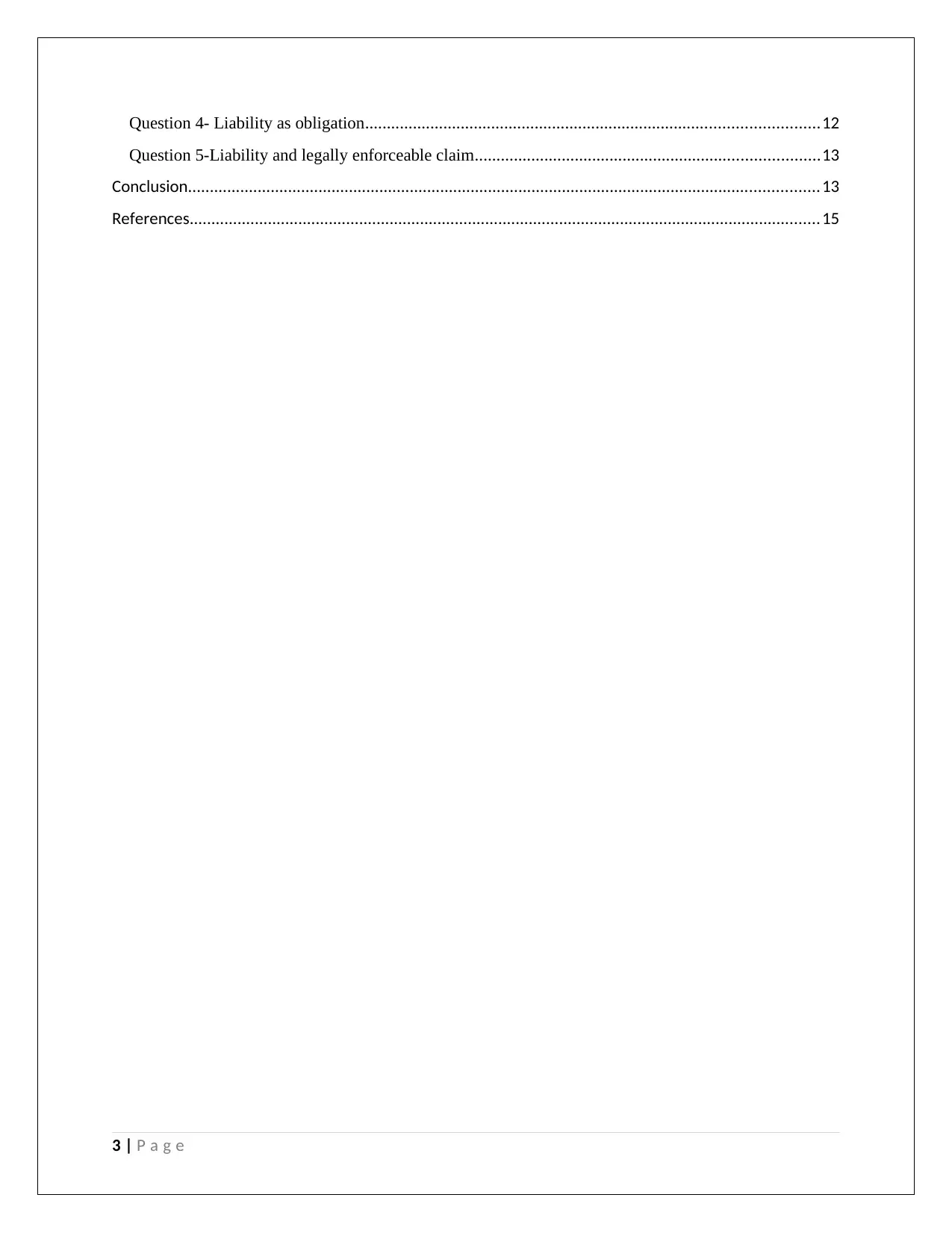
Question 4- Liability as obligation........................................................................................................12
Question 5-Liability and legally enforceable claim...............................................................................13
Conclusion.................................................................................................................................................13
References.................................................................................................................................................15
3 | P a g e
Question 5-Liability and legally enforceable claim...............................................................................13
Conclusion.................................................................................................................................................13
References.................................................................................................................................................15
3 | P a g e
⊘ This is a preview!⊘
Do you want full access?
Subscribe today to unlock all pages.

Trusted by 1+ million students worldwide
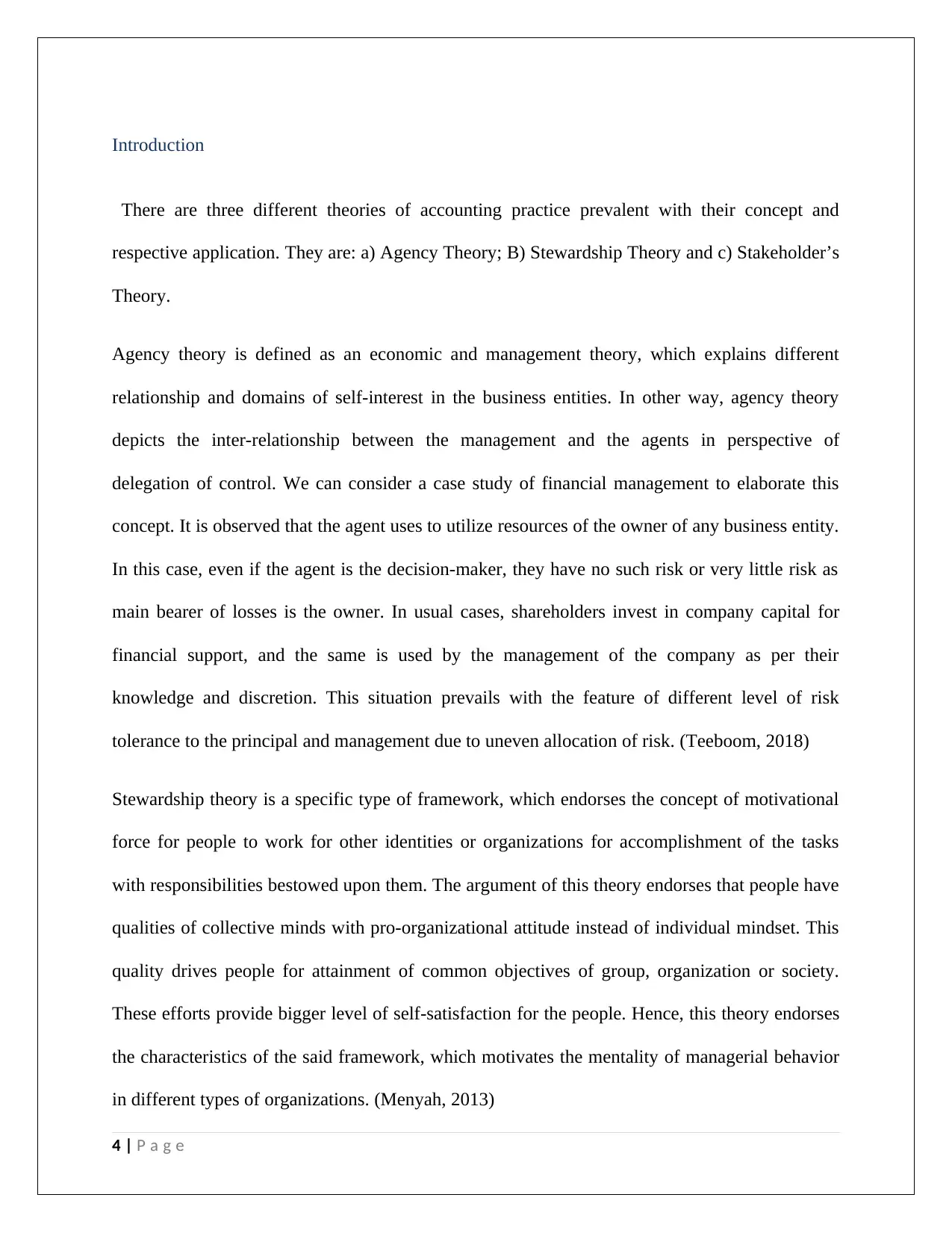
Introduction
There are three different theories of accounting practice prevalent with their concept and
respective application. They are: a) Agency Theory; B) Stewardship Theory and c) Stakeholder’s
Theory.
Agency theory is defined as an economic and management theory, which explains different
relationship and domains of self-interest in the business entities. In other way, agency theory
depicts the inter-relationship between the management and the agents in perspective of
delegation of control. We can consider a case study of financial management to elaborate this
concept. It is observed that the agent uses to utilize resources of the owner of any business entity.
In this case, even if the agent is the decision-maker, they have no such risk or very little risk as
main bearer of losses is the owner. In usual cases, shareholders invest in company capital for
financial support, and the same is used by the management of the company as per their
knowledge and discretion. This situation prevails with the feature of different level of risk
tolerance to the principal and management due to uneven allocation of risk. (Teeboom, 2018)
Stewardship theory is a specific type of framework, which endorses the concept of motivational
force for people to work for other identities or organizations for accomplishment of the tasks
with responsibilities bestowed upon them. The argument of this theory endorses that people have
qualities of collective minds with pro-organizational attitude instead of individual mindset. This
quality drives people for attainment of common objectives of group, organization or society.
These efforts provide bigger level of self-satisfaction for the people. Hence, this theory endorses
the characteristics of the said framework, which motivates the mentality of managerial behavior
in different types of organizations. (Menyah, 2013)
4 | P a g e
There are three different theories of accounting practice prevalent with their concept and
respective application. They are: a) Agency Theory; B) Stewardship Theory and c) Stakeholder’s
Theory.
Agency theory is defined as an economic and management theory, which explains different
relationship and domains of self-interest in the business entities. In other way, agency theory
depicts the inter-relationship between the management and the agents in perspective of
delegation of control. We can consider a case study of financial management to elaborate this
concept. It is observed that the agent uses to utilize resources of the owner of any business entity.
In this case, even if the agent is the decision-maker, they have no such risk or very little risk as
main bearer of losses is the owner. In usual cases, shareholders invest in company capital for
financial support, and the same is used by the management of the company as per their
knowledge and discretion. This situation prevails with the feature of different level of risk
tolerance to the principal and management due to uneven allocation of risk. (Teeboom, 2018)
Stewardship theory is a specific type of framework, which endorses the concept of motivational
force for people to work for other identities or organizations for accomplishment of the tasks
with responsibilities bestowed upon them. The argument of this theory endorses that people have
qualities of collective minds with pro-organizational attitude instead of individual mindset. This
quality drives people for attainment of common objectives of group, organization or society.
These efforts provide bigger level of self-satisfaction for the people. Hence, this theory endorses
the characteristics of the said framework, which motivates the mentality of managerial behavior
in different types of organizations. (Menyah, 2013)
4 | P a g e
Paraphrase This Document
Need a fresh take? Get an instant paraphrase of this document with our AI Paraphraser
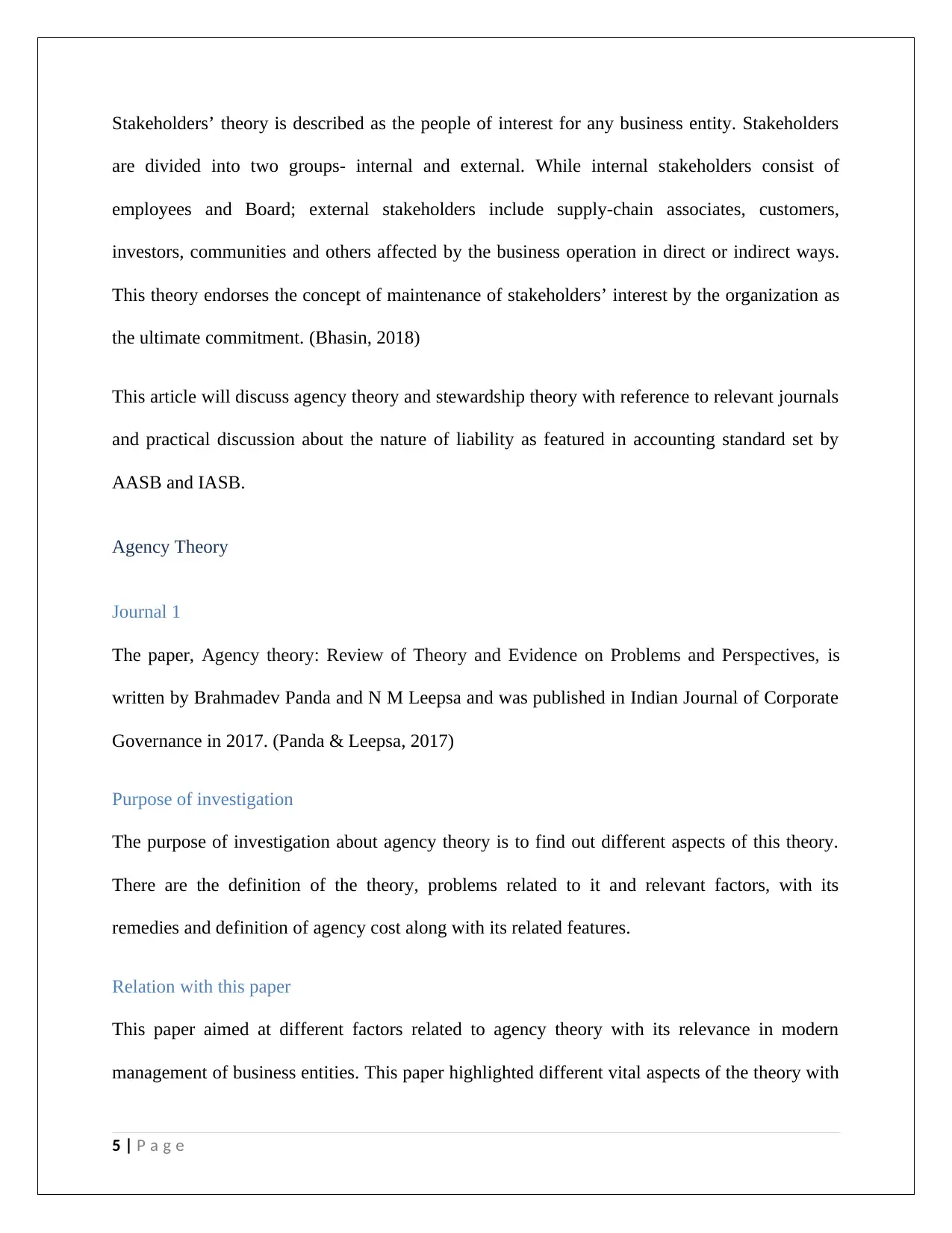
Stakeholders’ theory is described as the people of interest for any business entity. Stakeholders
are divided into two groups- internal and external. While internal stakeholders consist of
employees and Board; external stakeholders include supply-chain associates, customers,
investors, communities and others affected by the business operation in direct or indirect ways.
This theory endorses the concept of maintenance of stakeholders’ interest by the organization as
the ultimate commitment. (Bhasin, 2018)
This article will discuss agency theory and stewardship theory with reference to relevant journals
and practical discussion about the nature of liability as featured in accounting standard set by
AASB and IASB.
Agency Theory
Journal 1
The paper, Agency theory: Review of Theory and Evidence on Problems and Perspectives, is
written by Brahmadev Panda and N M Leepsa and was published in Indian Journal of Corporate
Governance in 2017. (Panda & Leepsa, 2017)
Purpose of investigation
The purpose of investigation about agency theory is to find out different aspects of this theory.
There are the definition of the theory, problems related to it and relevant factors, with its
remedies and definition of agency cost along with its related features.
Relation with this paper
This paper aimed at different factors related to agency theory with its relevance in modern
management of business entities. This paper highlighted different vital aspects of the theory with
5 | P a g e
are divided into two groups- internal and external. While internal stakeholders consist of
employees and Board; external stakeholders include supply-chain associates, customers,
investors, communities and others affected by the business operation in direct or indirect ways.
This theory endorses the concept of maintenance of stakeholders’ interest by the organization as
the ultimate commitment. (Bhasin, 2018)
This article will discuss agency theory and stewardship theory with reference to relevant journals
and practical discussion about the nature of liability as featured in accounting standard set by
AASB and IASB.
Agency Theory
Journal 1
The paper, Agency theory: Review of Theory and Evidence on Problems and Perspectives, is
written by Brahmadev Panda and N M Leepsa and was published in Indian Journal of Corporate
Governance in 2017. (Panda & Leepsa, 2017)
Purpose of investigation
The purpose of investigation about agency theory is to find out different aspects of this theory.
There are the definition of the theory, problems related to it and relevant factors, with its
remedies and definition of agency cost along with its related features.
Relation with this paper
This paper aimed at different factors related to agency theory with its relevance in modern
management of business entities. This paper highlighted different vital aspects of the theory with
5 | P a g e
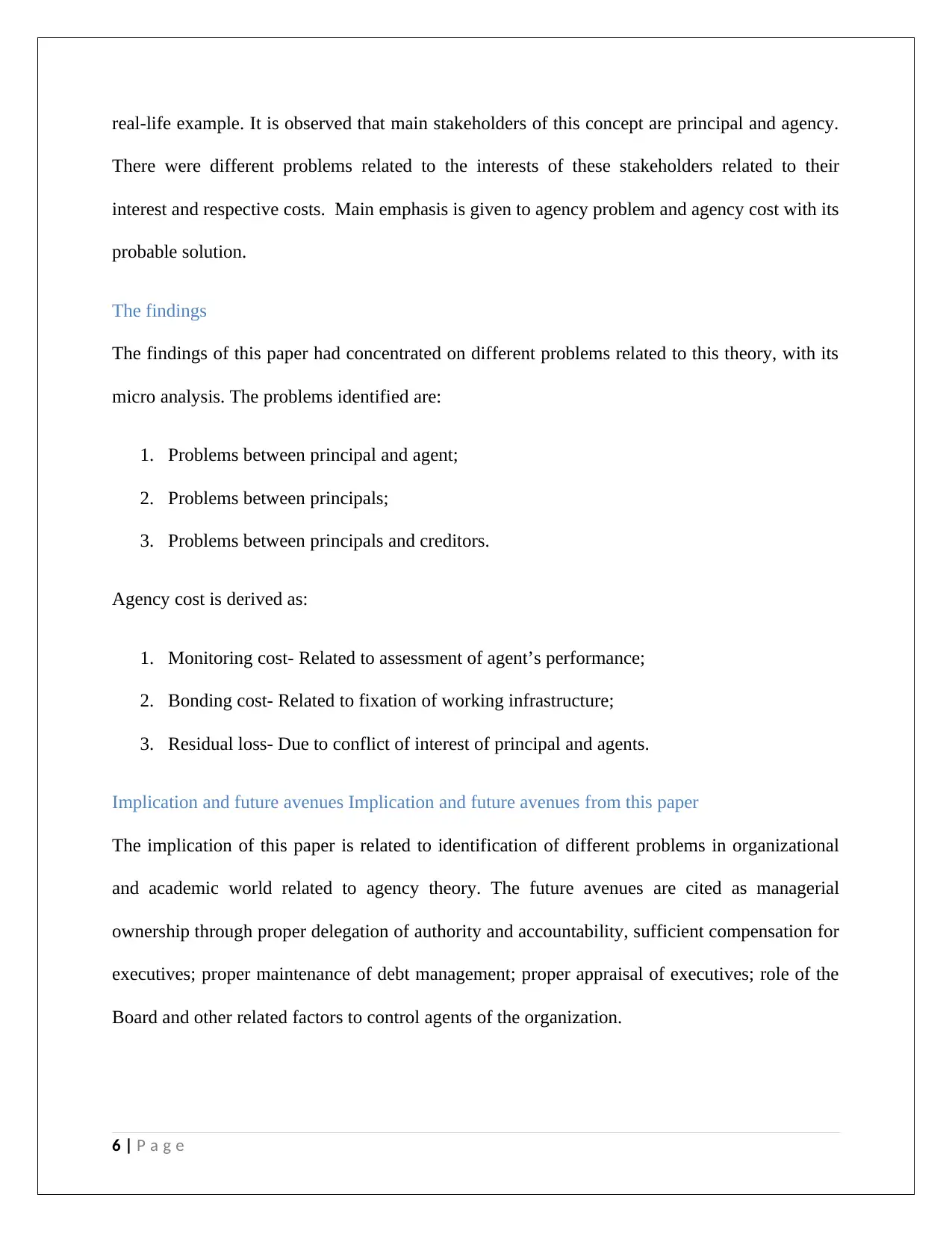
real-life example. It is observed that main stakeholders of this concept are principal and agency.
There were different problems related to the interests of these stakeholders related to their
interest and respective costs. Main emphasis is given to agency problem and agency cost with its
probable solution.
The findings
The findings of this paper had concentrated on different problems related to this theory, with its
micro analysis. The problems identified are:
1. Problems between principal and agent;
2. Problems between principals;
3. Problems between principals and creditors.
Agency cost is derived as:
1. Monitoring cost- Related to assessment of agent’s performance;
2. Bonding cost- Related to fixation of working infrastructure;
3. Residual loss- Due to conflict of interest of principal and agents.
Implication and future avenues Implication and future avenues from this paper
The implication of this paper is related to identification of different problems in organizational
and academic world related to agency theory. The future avenues are cited as managerial
ownership through proper delegation of authority and accountability, sufficient compensation for
executives; proper maintenance of debt management; proper appraisal of executives; role of the
Board and other related factors to control agents of the organization.
6 | P a g e
There were different problems related to the interests of these stakeholders related to their
interest and respective costs. Main emphasis is given to agency problem and agency cost with its
probable solution.
The findings
The findings of this paper had concentrated on different problems related to this theory, with its
micro analysis. The problems identified are:
1. Problems between principal and agent;
2. Problems between principals;
3. Problems between principals and creditors.
Agency cost is derived as:
1. Monitoring cost- Related to assessment of agent’s performance;
2. Bonding cost- Related to fixation of working infrastructure;
3. Residual loss- Due to conflict of interest of principal and agents.
Implication and future avenues Implication and future avenues from this paper
The implication of this paper is related to identification of different problems in organizational
and academic world related to agency theory. The future avenues are cited as managerial
ownership through proper delegation of authority and accountability, sufficient compensation for
executives; proper maintenance of debt management; proper appraisal of executives; role of the
Board and other related factors to control agents of the organization.
6 | P a g e
⊘ This is a preview!⊘
Do you want full access?
Subscribe today to unlock all pages.

Trusted by 1+ million students worldwide
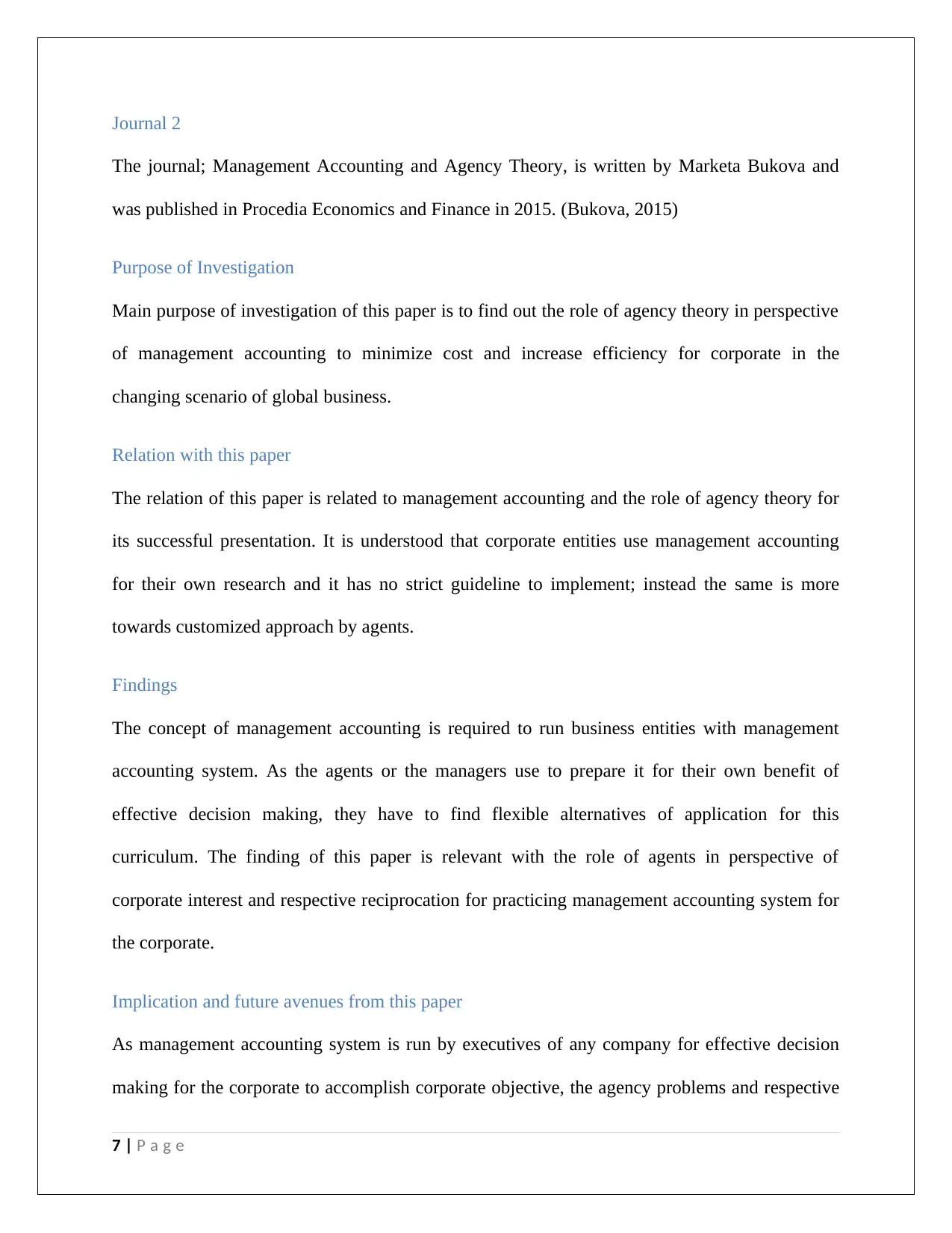
Journal 2
The journal; Management Accounting and Agency Theory, is written by Marketa Bukova and
was published in Procedia Economics and Finance in 2015. (Bukova, 2015)
Purpose of Investigation
Main purpose of investigation of this paper is to find out the role of agency theory in perspective
of management accounting to minimize cost and increase efficiency for corporate in the
changing scenario of global business.
Relation with this paper
The relation of this paper is related to management accounting and the role of agency theory for
its successful presentation. It is understood that corporate entities use management accounting
for their own research and it has no strict guideline to implement; instead the same is more
towards customized approach by agents.
Findings
The concept of management accounting is required to run business entities with management
accounting system. As the agents or the managers use to prepare it for their own benefit of
effective decision making, they have to find flexible alternatives of application for this
curriculum. The finding of this paper is relevant with the role of agents in perspective of
corporate interest and respective reciprocation for practicing management accounting system for
the corporate.
Implication and future avenues from this paper
As management accounting system is run by executives of any company for effective decision
making for the corporate to accomplish corporate objective, the agency problems and respective
7 | P a g e
The journal; Management Accounting and Agency Theory, is written by Marketa Bukova and
was published in Procedia Economics and Finance in 2015. (Bukova, 2015)
Purpose of Investigation
Main purpose of investigation of this paper is to find out the role of agency theory in perspective
of management accounting to minimize cost and increase efficiency for corporate in the
changing scenario of global business.
Relation with this paper
The relation of this paper is related to management accounting and the role of agency theory for
its successful presentation. It is understood that corporate entities use management accounting
for their own research and it has no strict guideline to implement; instead the same is more
towards customized approach by agents.
Findings
The concept of management accounting is required to run business entities with management
accounting system. As the agents or the managers use to prepare it for their own benefit of
effective decision making, they have to find flexible alternatives of application for this
curriculum. The finding of this paper is relevant with the role of agents in perspective of
corporate interest and respective reciprocation for practicing management accounting system for
the corporate.
Implication and future avenues from this paper
As management accounting system is run by executives of any company for effective decision
making for the corporate to accomplish corporate objective, the agency problems and respective
7 | P a g e
Paraphrase This Document
Need a fresh take? Get an instant paraphrase of this document with our AI Paraphraser
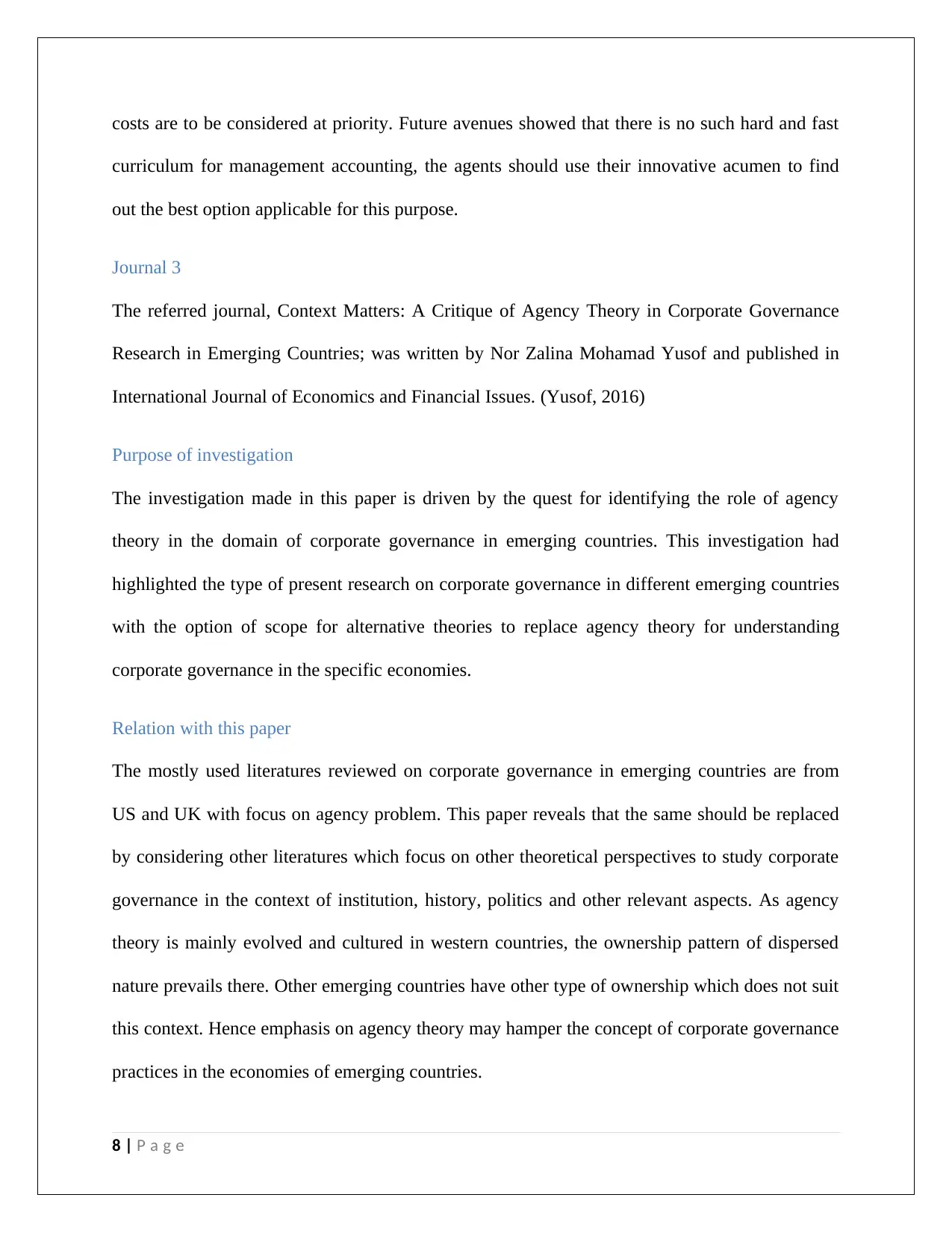
costs are to be considered at priority. Future avenues showed that there is no such hard and fast
curriculum for management accounting, the agents should use their innovative acumen to find
out the best option applicable for this purpose.
Journal 3
The referred journal, Context Matters: A Critique of Agency Theory in Corporate Governance
Research in Emerging Countries; was written by Nor Zalina Mohamad Yusof and published in
International Journal of Economics and Financial Issues. (Yusof, 2016)
Purpose of investigation
The investigation made in this paper is driven by the quest for identifying the role of agency
theory in the domain of corporate governance in emerging countries. This investigation had
highlighted the type of present research on corporate governance in different emerging countries
with the option of scope for alternative theories to replace agency theory for understanding
corporate governance in the specific economies.
Relation with this paper
The mostly used literatures reviewed on corporate governance in emerging countries are from
US and UK with focus on agency problem. This paper reveals that the same should be replaced
by considering other literatures which focus on other theoretical perspectives to study corporate
governance in the context of institution, history, politics and other relevant aspects. As agency
theory is mainly evolved and cultured in western countries, the ownership pattern of dispersed
nature prevails there. Other emerging countries have other type of ownership which does not suit
this context. Hence emphasis on agency theory may hamper the concept of corporate governance
practices in the economies of emerging countries.
8 | P a g e
curriculum for management accounting, the agents should use their innovative acumen to find
out the best option applicable for this purpose.
Journal 3
The referred journal, Context Matters: A Critique of Agency Theory in Corporate Governance
Research in Emerging Countries; was written by Nor Zalina Mohamad Yusof and published in
International Journal of Economics and Financial Issues. (Yusof, 2016)
Purpose of investigation
The investigation made in this paper is driven by the quest for identifying the role of agency
theory in the domain of corporate governance in emerging countries. This investigation had
highlighted the type of present research on corporate governance in different emerging countries
with the option of scope for alternative theories to replace agency theory for understanding
corporate governance in the specific economies.
Relation with this paper
The mostly used literatures reviewed on corporate governance in emerging countries are from
US and UK with focus on agency problem. This paper reveals that the same should be replaced
by considering other literatures which focus on other theoretical perspectives to study corporate
governance in the context of institution, history, politics and other relevant aspects. As agency
theory is mainly evolved and cultured in western countries, the ownership pattern of dispersed
nature prevails there. Other emerging countries have other type of ownership which does not suit
this context. Hence emphasis on agency theory may hamper the concept of corporate governance
practices in the economies of emerging countries.
8 | P a g e
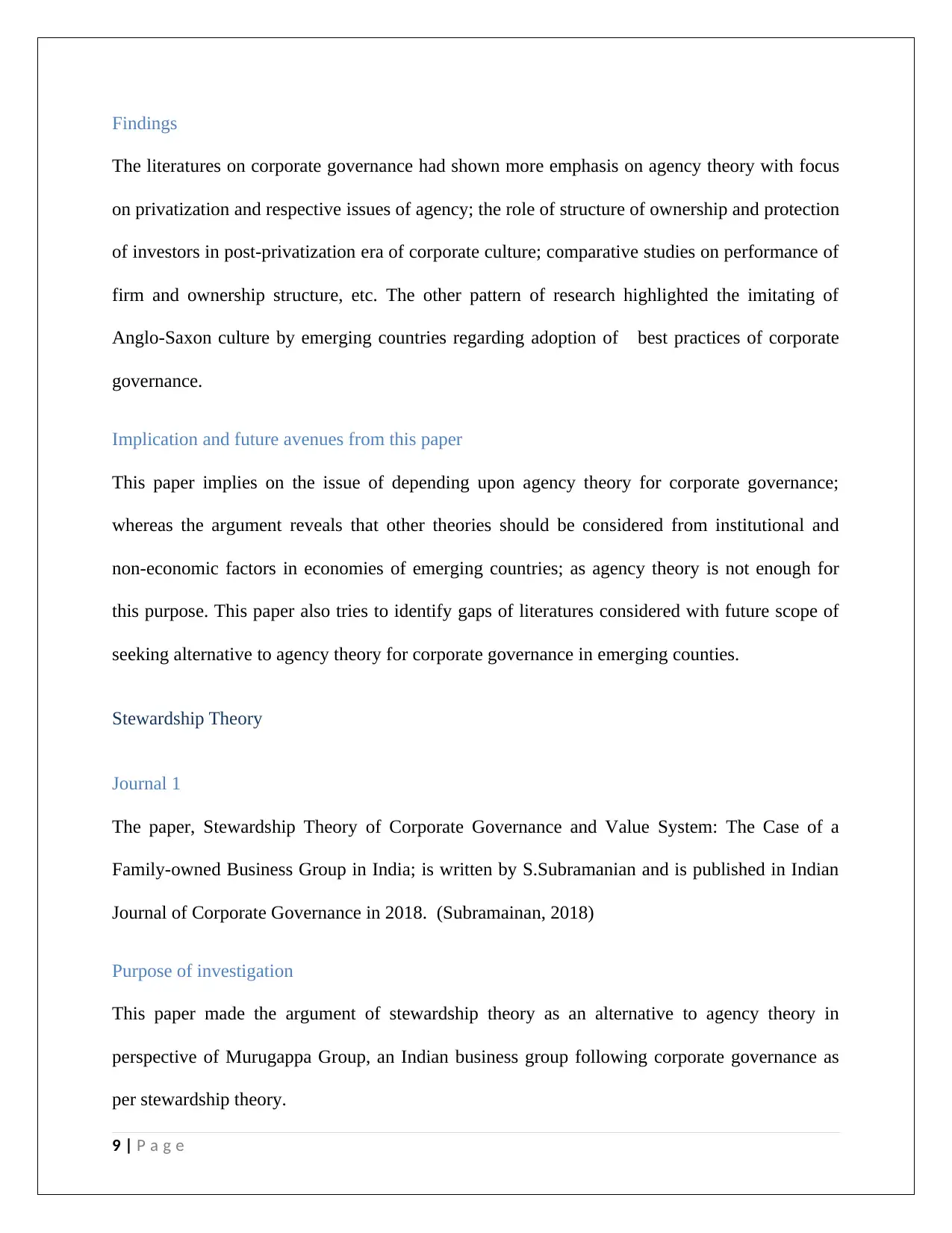
Findings
The literatures on corporate governance had shown more emphasis on agency theory with focus
on privatization and respective issues of agency; the role of structure of ownership and protection
of investors in post-privatization era of corporate culture; comparative studies on performance of
firm and ownership structure, etc. The other pattern of research highlighted the imitating of
Anglo-Saxon culture by emerging countries regarding adoption of best practices of corporate
governance.
Implication and future avenues from this paper
This paper implies on the issue of depending upon agency theory for corporate governance;
whereas the argument reveals that other theories should be considered from institutional and
non-economic factors in economies of emerging countries; as agency theory is not enough for
this purpose. This paper also tries to identify gaps of literatures considered with future scope of
seeking alternative to agency theory for corporate governance in emerging counties.
Stewardship Theory
Journal 1
The paper, Stewardship Theory of Corporate Governance and Value System: The Case of a
Family-owned Business Group in India; is written by S.Subramanian and is published in Indian
Journal of Corporate Governance in 2018. (Subramainan, 2018)
Purpose of investigation
This paper made the argument of stewardship theory as an alternative to agency theory in
perspective of Murugappa Group, an Indian business group following corporate governance as
per stewardship theory.
9 | P a g e
The literatures on corporate governance had shown more emphasis on agency theory with focus
on privatization and respective issues of agency; the role of structure of ownership and protection
of investors in post-privatization era of corporate culture; comparative studies on performance of
firm and ownership structure, etc. The other pattern of research highlighted the imitating of
Anglo-Saxon culture by emerging countries regarding adoption of best practices of corporate
governance.
Implication and future avenues from this paper
This paper implies on the issue of depending upon agency theory for corporate governance;
whereas the argument reveals that other theories should be considered from institutional and
non-economic factors in economies of emerging countries; as agency theory is not enough for
this purpose. This paper also tries to identify gaps of literatures considered with future scope of
seeking alternative to agency theory for corporate governance in emerging counties.
Stewardship Theory
Journal 1
The paper, Stewardship Theory of Corporate Governance and Value System: The Case of a
Family-owned Business Group in India; is written by S.Subramanian and is published in Indian
Journal of Corporate Governance in 2018. (Subramainan, 2018)
Purpose of investigation
This paper made the argument of stewardship theory as an alternative to agency theory in
perspective of Murugappa Group, an Indian business group following corporate governance as
per stewardship theory.
9 | P a g e
⊘ This is a preview!⊘
Do you want full access?
Subscribe today to unlock all pages.

Trusted by 1+ million students worldwide
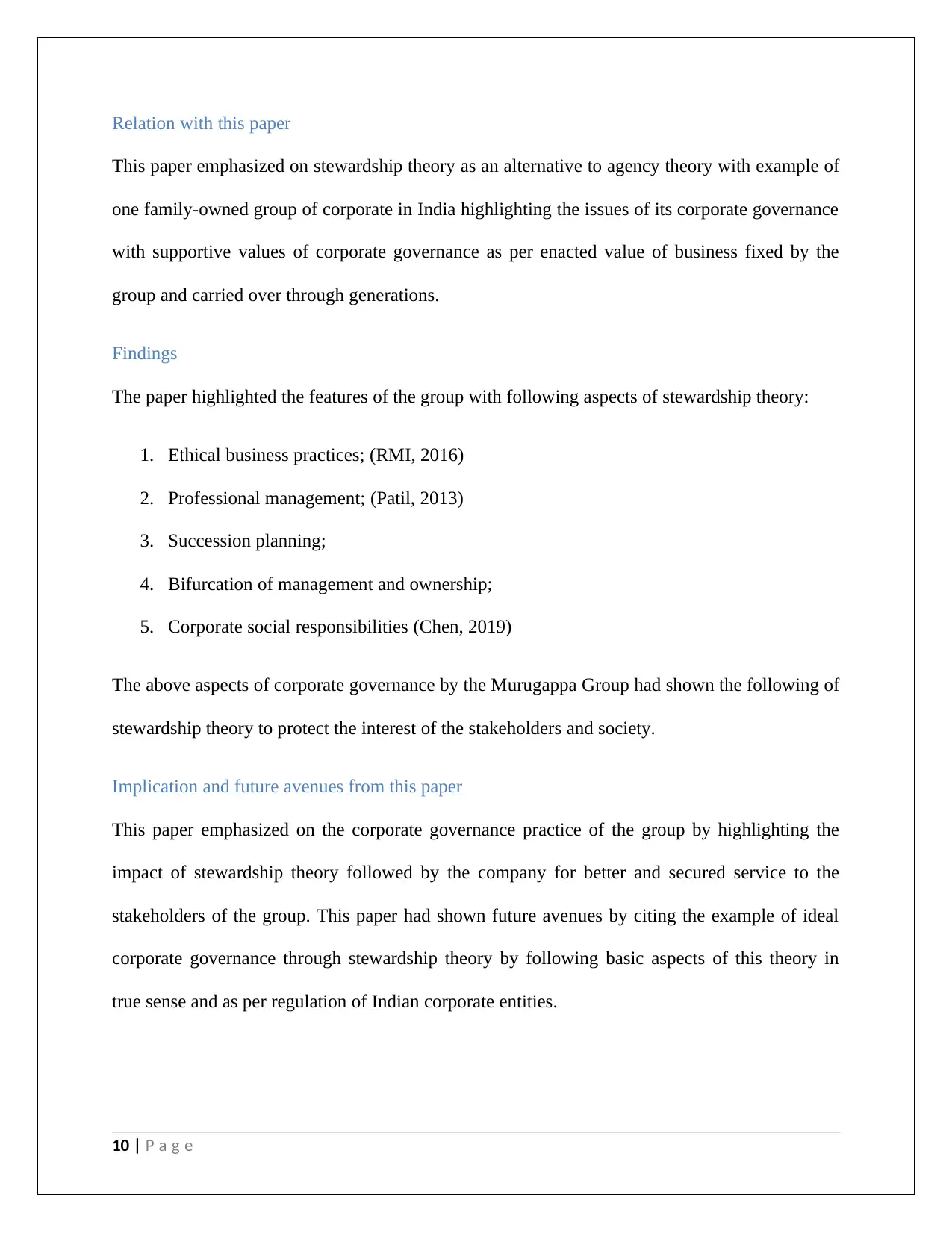
Relation with this paper
This paper emphasized on stewardship theory as an alternative to agency theory with example of
one family-owned group of corporate in India highlighting the issues of its corporate governance
with supportive values of corporate governance as per enacted value of business fixed by the
group and carried over through generations.
Findings
The paper highlighted the features of the group with following aspects of stewardship theory:
1. Ethical business practices; (RMI, 2016)
2. Professional management; (Patil, 2013)
3. Succession planning;
4. Bifurcation of management and ownership;
5. Corporate social responsibilities (Chen, 2019)
The above aspects of corporate governance by the Murugappa Group had shown the following of
stewardship theory to protect the interest of the stakeholders and society.
Implication and future avenues from this paper
This paper emphasized on the corporate governance practice of the group by highlighting the
impact of stewardship theory followed by the company for better and secured service to the
stakeholders of the group. This paper had shown future avenues by citing the example of ideal
corporate governance through stewardship theory by following basic aspects of this theory in
true sense and as per regulation of Indian corporate entities.
10 | P a g e
This paper emphasized on stewardship theory as an alternative to agency theory with example of
one family-owned group of corporate in India highlighting the issues of its corporate governance
with supportive values of corporate governance as per enacted value of business fixed by the
group and carried over through generations.
Findings
The paper highlighted the features of the group with following aspects of stewardship theory:
1. Ethical business practices; (RMI, 2016)
2. Professional management; (Patil, 2013)
3. Succession planning;
4. Bifurcation of management and ownership;
5. Corporate social responsibilities (Chen, 2019)
The above aspects of corporate governance by the Murugappa Group had shown the following of
stewardship theory to protect the interest of the stakeholders and society.
Implication and future avenues from this paper
This paper emphasized on the corporate governance practice of the group by highlighting the
impact of stewardship theory followed by the company for better and secured service to the
stakeholders of the group. This paper had shown future avenues by citing the example of ideal
corporate governance through stewardship theory by following basic aspects of this theory in
true sense and as per regulation of Indian corporate entities.
10 | P a g e
Paraphrase This Document
Need a fresh take? Get an instant paraphrase of this document with our AI Paraphraser
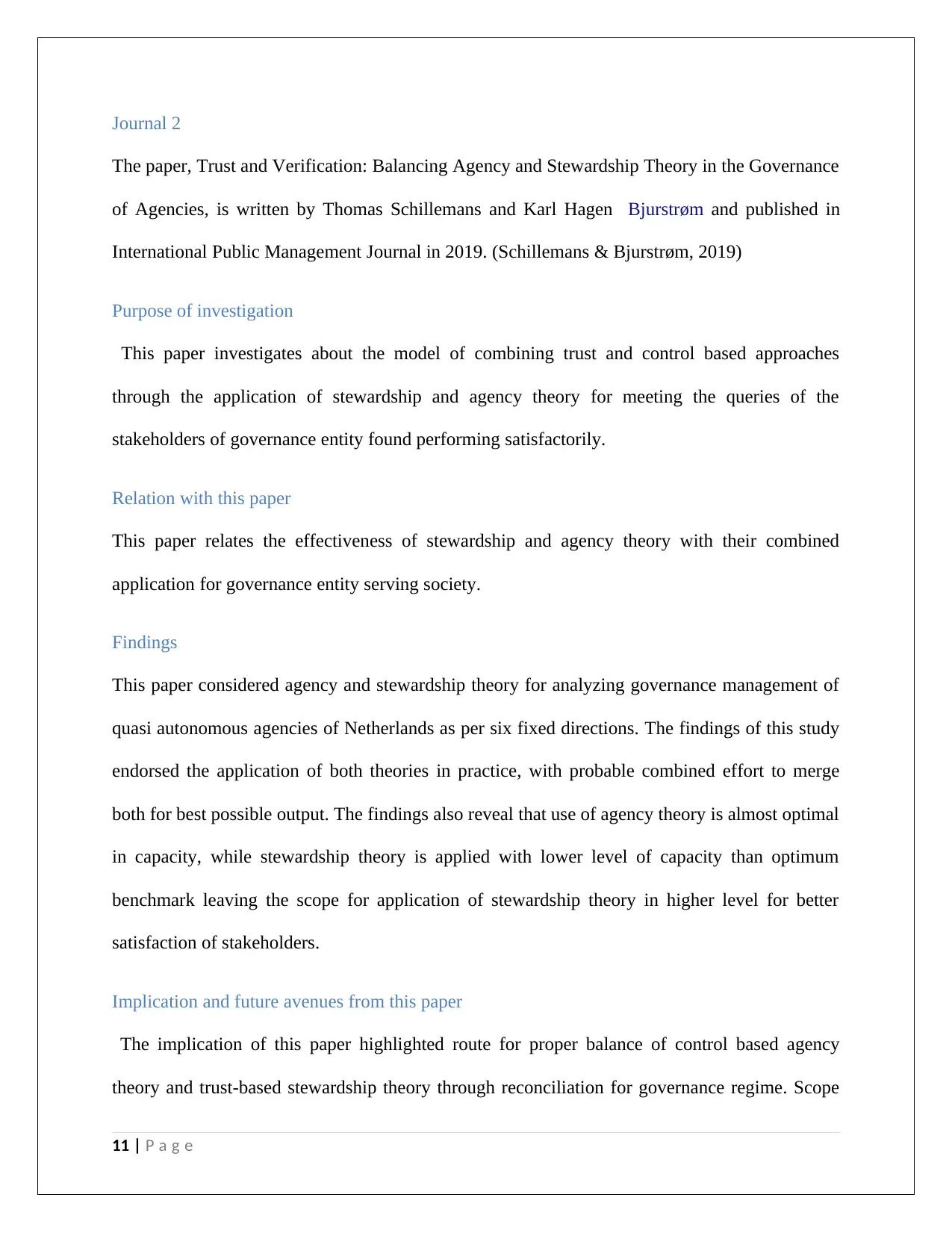
Journal 2
The paper, Trust and Verification: Balancing Agency and Stewardship Theory in the Governance
of Agencies, is written by Thomas Schillemans and Karl Hagen Bjurstrøm and published in
International Public Management Journal in 2019. (Schillemans & Bjurstrøm, 2019)
Purpose of investigation
This paper investigates about the model of combining trust and control based approaches
through the application of stewardship and agency theory for meeting the queries of the
stakeholders of governance entity found performing satisfactorily.
Relation with this paper
This paper relates the effectiveness of stewardship and agency theory with their combined
application for governance entity serving society.
Findings
This paper considered agency and stewardship theory for analyzing governance management of
quasi autonomous agencies of Netherlands as per six fixed directions. The findings of this study
endorsed the application of both theories in practice, with probable combined effort to merge
both for best possible output. The findings also reveal that use of agency theory is almost optimal
in capacity, while stewardship theory is applied with lower level of capacity than optimum
benchmark leaving the scope for application of stewardship theory in higher level for better
satisfaction of stakeholders.
Implication and future avenues from this paper
The implication of this paper highlighted route for proper balance of control based agency
theory and trust-based stewardship theory through reconciliation for governance regime. Scope
11 | P a g e
The paper, Trust and Verification: Balancing Agency and Stewardship Theory in the Governance
of Agencies, is written by Thomas Schillemans and Karl Hagen Bjurstrøm and published in
International Public Management Journal in 2019. (Schillemans & Bjurstrøm, 2019)
Purpose of investigation
This paper investigates about the model of combining trust and control based approaches
through the application of stewardship and agency theory for meeting the queries of the
stakeholders of governance entity found performing satisfactorily.
Relation with this paper
This paper relates the effectiveness of stewardship and agency theory with their combined
application for governance entity serving society.
Findings
This paper considered agency and stewardship theory for analyzing governance management of
quasi autonomous agencies of Netherlands as per six fixed directions. The findings of this study
endorsed the application of both theories in practice, with probable combined effort to merge
both for best possible output. The findings also reveal that use of agency theory is almost optimal
in capacity, while stewardship theory is applied with lower level of capacity than optimum
benchmark leaving the scope for application of stewardship theory in higher level for better
satisfaction of stakeholders.
Implication and future avenues from this paper
The implication of this paper highlighted route for proper balance of control based agency
theory and trust-based stewardship theory through reconciliation for governance regime. Scope
11 | P a g e
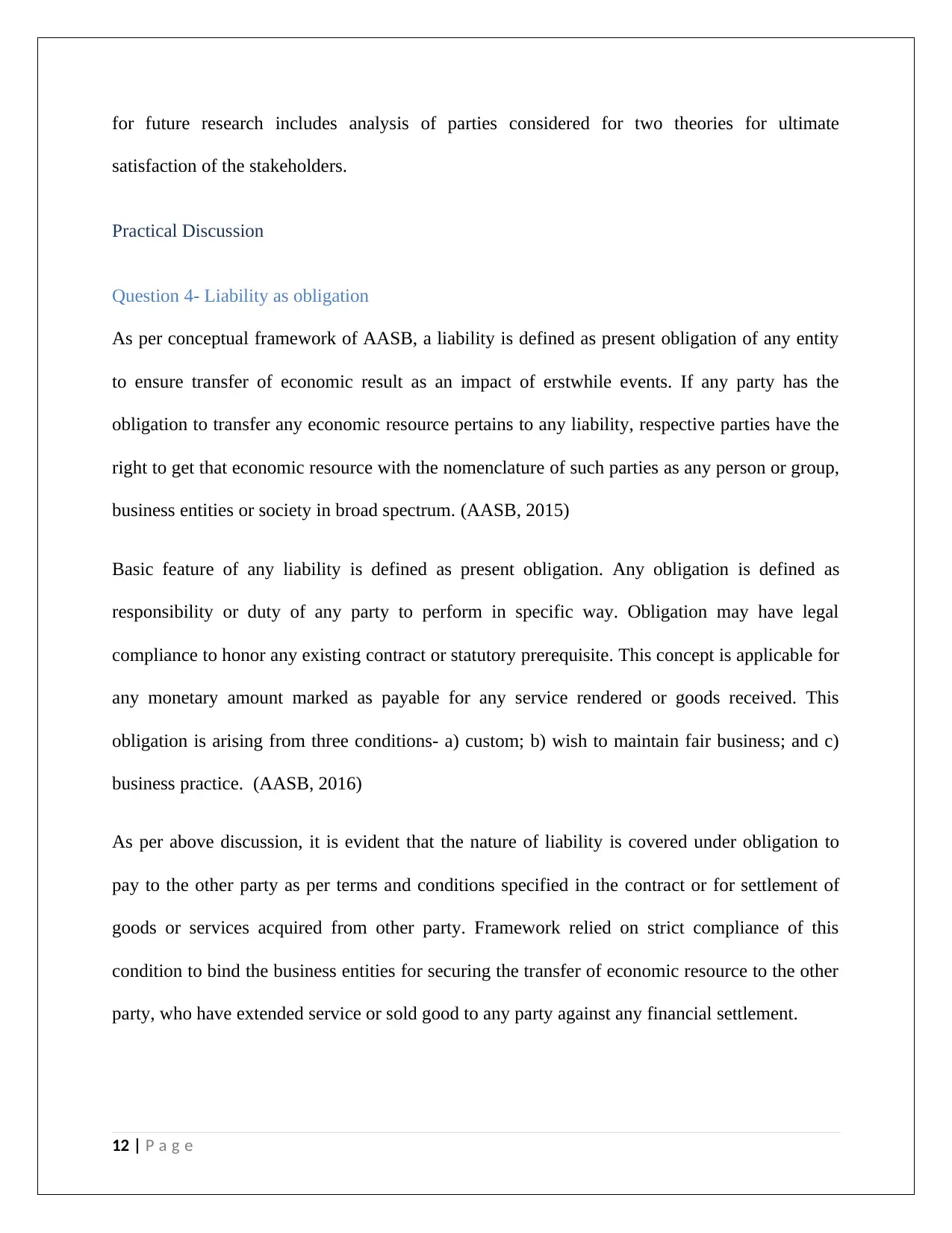
for future research includes analysis of parties considered for two theories for ultimate
satisfaction of the stakeholders.
Practical Discussion
Question 4- Liability as obligation
As per conceptual framework of AASB, a liability is defined as present obligation of any entity
to ensure transfer of economic result as an impact of erstwhile events. If any party has the
obligation to transfer any economic resource pertains to any liability, respective parties have the
right to get that economic resource with the nomenclature of such parties as any person or group,
business entities or society in broad spectrum. (AASB, 2015)
Basic feature of any liability is defined as present obligation. Any obligation is defined as
responsibility or duty of any party to perform in specific way. Obligation may have legal
compliance to honor any existing contract or statutory prerequisite. This concept is applicable for
any monetary amount marked as payable for any service rendered or goods received. This
obligation is arising from three conditions- a) custom; b) wish to maintain fair business; and c)
business practice. (AASB, 2016)
As per above discussion, it is evident that the nature of liability is covered under obligation to
pay to the other party as per terms and conditions specified in the contract or for settlement of
goods or services acquired from other party. Framework relied on strict compliance of this
condition to bind the business entities for securing the transfer of economic resource to the other
party, who have extended service or sold good to any party against any financial settlement.
12 | P a g e
satisfaction of the stakeholders.
Practical Discussion
Question 4- Liability as obligation
As per conceptual framework of AASB, a liability is defined as present obligation of any entity
to ensure transfer of economic result as an impact of erstwhile events. If any party has the
obligation to transfer any economic resource pertains to any liability, respective parties have the
right to get that economic resource with the nomenclature of such parties as any person or group,
business entities or society in broad spectrum. (AASB, 2015)
Basic feature of any liability is defined as present obligation. Any obligation is defined as
responsibility or duty of any party to perform in specific way. Obligation may have legal
compliance to honor any existing contract or statutory prerequisite. This concept is applicable for
any monetary amount marked as payable for any service rendered or goods received. This
obligation is arising from three conditions- a) custom; b) wish to maintain fair business; and c)
business practice. (AASB, 2016)
As per above discussion, it is evident that the nature of liability is covered under obligation to
pay to the other party as per terms and conditions specified in the contract or for settlement of
goods or services acquired from other party. Framework relied on strict compliance of this
condition to bind the business entities for securing the transfer of economic resource to the other
party, who have extended service or sold good to any party against any financial settlement.
12 | P a g e
⊘ This is a preview!⊘
Do you want full access?
Subscribe today to unlock all pages.

Trusted by 1+ million students worldwide
1 out of 16
Related Documents
Your All-in-One AI-Powered Toolkit for Academic Success.
+13062052269
info@desklib.com
Available 24*7 on WhatsApp / Email
![[object Object]](/_next/static/media/star-bottom.7253800d.svg)
Unlock your academic potential
Copyright © 2020–2025 A2Z Services. All Rights Reserved. Developed and managed by ZUCOL.





